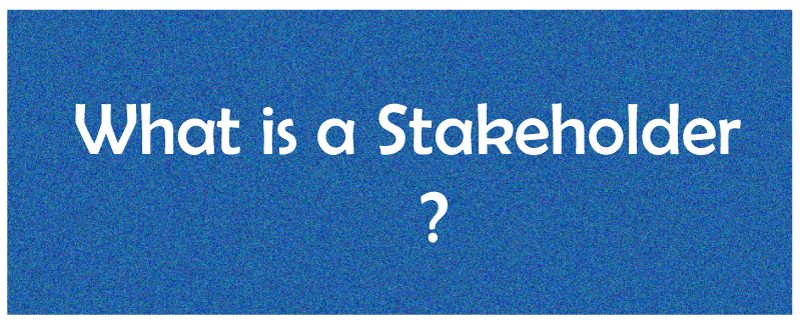What Are Stakeholders: Definition, Types, and ExamplesWhat is a Stakeholder?A stakeholder is a party with interest in a business who has the potential to influence or be affected by it. Generally, any person, institution, or group who has an interest in a business and who is affected by the results of its operations and performance is referred to as a stakeholder. A typical company's "Investors", "Employees", "Customers", and "Suppliers" make up its primary stakeholders. 
However, the idea has been broadened to incorporate communities, governments, and trade groups as a result of the growing focus on corporate social responsibility. Types of StakeholdersInternal and External stakeholders are the two different categories of stakeholders, which can be explained as the following: Internal StakeholdersAn individual party who directly or financially contributes to the functioning of the company is referred to as an internal stakeholder. If the organization succeeds, they are more likely to make a monetary profit. Some typical internal stakeholders are listed below: Employees A company's well-being depends on strategic management of its workforce to preserve the quality of the product and employee confidence. Employees of a firm are important stakeholders because they produce the products and services that a company offers, and the level of their work directly affects customer service. Employees also gain financially from the business's ongoing success and performance. Owners The company's top executives are also stakeholders. They often make important business decisions, such as how to grow the company and what activities are essential to engage in. Their decisions might draw a significant impact on the firm's present and future company operations. Additionally, how well they manage the business will have an impact on their reputation and their capacity to create new possibilities. Managers In addition to allocating responsibilities and ensuring that staff members have the proper instructions for doing specific jobs, managers personally supervise employees inside their division and carry out the strategies conveyed to them by the owner in the plan. In order to successfully accomplish corporate goals, managers must complete their jobs and ensure that their staff members meet their goals. All managers have an impact on the comprehensive plan that the owners choose to adopt and evaluate success against. External StakeholdersAn external stakeholder is a party recognized by a firm that makes operational decisions. External stakeholders indirectly affect the business through their decisions, such as whether they buy a product or how well of a relationship they have with a corporation. Some typical external stakeholders are listed below: Customers A customer can be represented as an entity that is connected directly to the firm and its financial success. Additionally, the customers are treated as the primary stakeholder. Businesses exist largely to meet the demands of a customer and earn money from their purchases. Business owners typically see customers as the most important stakeholder because their support allows the organization to continue operating effectively. Investors and Shareholders There are various categories of primary shareholders, including investors, shareholders, and stockholders. Within an organization, shareholders hold one or more shares of the company. Many shareholders of a company's stock are external parties, such as clients and the general public. A shareholder is more likely to have more authority to make decisions on behalf of the employer if they hold more shares or ownership of the company. These decisions may relate to finances, hiring, techniques, and other factors. The views of its shareholders also influence owners' decisions regarding a company's strategies and target markets. Building good relationships with all shareholders can boost their interest in participating in a business while providing input on decisions to build products or services tailored to everybody's demands. Communities The individuals who reside close to a company's physical site constitute communities. Because residents' perceptions of a firm's facilities and compliance with environmental standards and other local, state, and federal laws can affect a company's reputation, the views of those residents have an impact on an organization. Having positive relationships with the community can help maintain the satisfaction of internal stakeholders and other external stakeholders like consumers, shareholders, and investors. How a firm interacts with the community can also affect whether residents choose to use its goods and services and support its financial success. Currently, businesses implement CSR programs that benefit local or global communities. Programs like volunteering help businesses establish ties with their local community and project an image that encourages interaction. In order to maximize the likelihood of future sales, businesses must concentrate on the communities where they can generate the most revenue. Creditors An individual, firm, or government may be a creditor if they lend money, goods, or services to an organization. Two categories of creditors exist:
Some of the assets belonging to a firm can be used as collateral by secured creditors, giving them a legal advantage.
Unsecured creditors include suppliers, clients, and contractors who can lend money without expecting anything in return, such as collateral. After an organization purchases or obtains a good, service, asset, or other things, a creditor may charge collateral. Maintaining good connections with creditors while having the funds to expand a business requires timely payments. If a firm is doing well, it is probably paying creditors on schedule and building trust with them. Government A company's stakeholders may also include state and federal governments. Government is the governing body of the nation under which businesses operate. Taxes are deducted by the government from both the company's earnings and employee salaries. Additionally, it ensures that businesses comply with labor rules that mandate safe working environments for workers. Additionally, it establishes rules for the financial sector to safeguard customers. This external stakeholder is particularly important to an organization's success because a firm must abide by federal, state, and local rules and regulations in order to operate and expand. A business can foster a good relationship with the government by complying with specified rules, being open when required, and looking for chances to collaborate with government organizations to offer services that will benefit both parties. Vendors and Suppliers Despite being external to a firm, suppliers and vendors are nonetheless seen as the main stakeholders because they immediately benefit from the profits made from sales and services, as does the business. However, they must work to increase the company's sales in order to generate profits. These suppliers supply firms with resources, materials, and frequently expertise that is not available internally, which can enhance a company's capacity to satisfy the needs of its customers and shareholders. Example of Internal StakeholdersInvestors are internal stakeholders who are heavily influenced by the associated company and its performance. A venture capital firm, for instance, becomes an internal stakeholder in a technological start-up if it chooses to invest $6 million in the company in exchange for 10% stock and substantial influence. The success or failure of the start-up determines whether the venture capital firm receives a return on its investment, so it has a stake in the outcome. Example of External ShareholderIn contrast to internal stakeholders, external stakeholders are not associated with the business directly. Instead, an external stakeholder is typically an individual or a group impacted by how the firm operates. When the company exceeds the permitted carbon emissions limit, for instance, the area where a firm is located can be regarded as an external stakeholder because it is impacted by increased pollution. On the other hand, outside parties with no obvious connection to the company may occasionally have a direct impact on it. A prime example of an external stakeholder is the government. Any organization with higher carbon levels may have business operations impact when the government alters its policies regarding carbon emissions. Shareholder vs. Stakeholders
Only one kind of stakeholder is a shareholder. Each stakeholder has a relationship with a corporation based on vested interests, frequently for a long period and for practical reasons. A shareholder has a financial interest in the firm, but they also have the option of selling their shares at any moment. As a result, they don't necessarily need to stay with the organization for a long period. For instance, suppose a firm's financial performance is poor; the connected vendors in its supply chain may suffer if the firm reduces production and stops utilizing its services. The firm's employees also run the risk of losing their employment. However, firm shareholders can sell their shares and cut their losses. Importance of StakeholdersStakeholders are crucial for several reasons. They are significant to internal stakeholders since the company's operations depend on their capacity to cooperate in achieving the company's objectives. On the other hand, external stakeholders may have an indirect impact on the firm. For example, Customers can alter their purchasing patterns, suppliers can alter how they manufacture and distribute their products, and governments can alter the laws and regulations. A firm's long-term viability ultimately depends on how well it manages relationships with internal and external stakeholders. Example of StakeholdersThere is a pecking order among the stakeholders about who gets paid back on their invested capital if a company fails and goes bankrupt. Priority is given to secured creditors, then unsecured creditors, preferred shareholders, and then holders of common stock. This illustration shows that not all stakeholders enjoy the same privilege or status. For instance, employees of the insolvent company may be let go without any notice. |
 For Videos Join Our Youtube Channel: Join Now
For Videos Join Our Youtube Channel: Join Now
Feedback
- Send your Feedback to [email protected]
Help Others, Please Share









